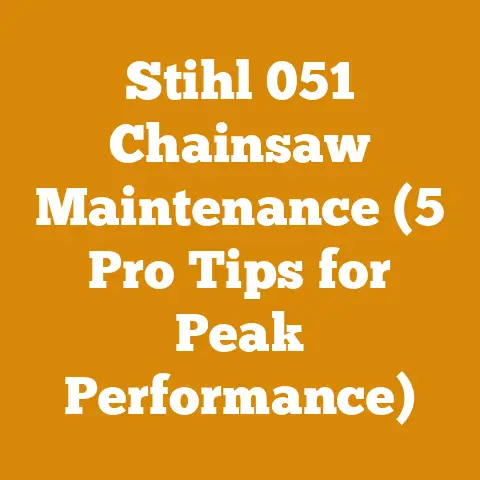Ground Hornets Removal Tips (Safe Wood Processing Solutions)
Here’s how to safely remove ground hornets while processing wood: A guide for keeping your firewood dreams alive and sting-free.
Let’s face it, the great outdoors is a shared space. And sometimes, our quest for the perfect firewood pile leads us into the buzzing domain of ground hornets. Nothing ruins a productive day of wood processing faster than an angry swarm. I’ve been there, done that, and have the welts to prove it! So, I’m going to share my hard-earned wisdom on how to safely remove ground hornets while processing wood, ensuring you, your wood, and the buzzing neighbors all coexist peacefully (or at least with minimal drama).
Understanding the Threat: Ground Hornets and Wood Processing
Before we dive into removal techniques, let’s understand what we’re dealing with. Ground hornets, often yellowjackets or bald-faced hornets nesting underground, are particularly aggressive when their nests are disturbed. Wood processing, especially activities like splitting logs or clearing brush, can inadvertently trigger their defenses.
Identifying the Enemy: What Are Ground Hornets?
- Yellowjackets: These are the most common culprits. They’re about ½ inch long, with black and yellow bands. They often nest in the ground, in decaying logs, or under piles of wood.
- Bald-faced Hornets: Despite the name, they are technically wasps. They’re larger than yellowjackets, about ¾ inch long, and have black and white markings. They typically build aerial nests but can occasionally nest in the ground.
Why Wood Processing Upsets Them
Think about it from their perspective. We’re essentially earthquake-inducing giants stomping around their homes. The vibrations from chainsaws, axes, and heavy machinery are like alarm bells, signaling danger. The closer you get to their nest, the more agitated they become.
The Sting Factor: Why Prevention is Key
A single sting is unpleasant, but multiple stings can be dangerous, especially for those with allergies. According to the Mayo Clinic, allergic reactions to insect stings can range from mild discomfort to life-threatening anaphylaxis. Prevention is therefore not just about comfort; it’s about safety.
Preemptive Measures: Scouting and Preparation
The best way to deal with ground hornets is to avoid them altogether. This starts with careful scouting and preparation before you even fire up your chainsaw.
Reconnaissance: Surveying the Area
Before you start any wood processing project, walk the area and look for signs of ground hornet activity.
- Observe Flight Paths: Pay attention to where hornets are flying. Are they consistently entering or exiting a specific spot in the ground?
- Look for Nest Entrances: These are usually small, inconspicuous holes in the ground.
- Listen for Buzzing: A faint, constant buzzing sound coming from the ground is a telltale sign of a nest.
I remember one time, I was so eager to start splitting a huge pile of oak that I completely skipped the scouting phase. Big mistake! Within minutes, I was being chased by a swarm of angry yellowjackets. Now, I always take the time to survey the area, even if it means delaying the satisfaction of splitting wood.
Protective Gear: Dressing for Battle (Safely)
If you suspect ground hornets are present, or even if you just want to be cautious, wear appropriate protective gear.
- Long Sleeves and Pants: Cover as much skin as possible.
- Gloves: Protect your hands. Leather gloves offer some protection against stings.
- Hat: A wide-brimmed hat can help keep hornets away from your face and neck.
- Eye Protection: Safety glasses or a face shield are essential for protecting your eyes from flying debris and potential stings.
- Light-Colored Clothing: Dark colors are believed to attract stinging insects.
- Consider a Bee Suit: For heavy infestations or if you’re highly allergic, a full bee suit is the best protection.
Timing is Everything: When to Process Wood
The time of day and year can influence hornet activity.
- Cooler Temperatures: Hornets are generally less active in the early morning or late evening when temperatures are cooler.
- Avoid Peak Activity: Hornets are most active during the warmest part of the day.
- Fall is Risky: As winter approaches, hornets become more desperate for food and more aggressive in defending their nests.
Safe Removal Techniques: When Prevention Fails
Despite your best efforts, you may still encounter a ground hornet nest while processing wood. Here are some safe removal techniques to consider. Note: I am not an exterminator. If you are dealing with a large or aggressive nest, it is best to call a professional.
The Wait-and-See Approach: Patience is a Virtue
Sometimes, the best approach is to simply wait. If you’ve only disturbed the nest slightly, the hornets may calm down after a short period.
- Give Them Space: Move away from the nest and observe from a distance.
- Monitor Activity: If the hornets remain agitated after an hour or two, you’ll need to consider other removal options.
The Distraction Tactic: Misdirection and Evasion
This involves creating a distraction to draw the hornets away from your work area.
- Sugar Water Trap: Place a container of sugar water a short distance from the nest. The hornets may be attracted to the sugar water, giving you a chance to work undisturbed.
- Smoke: Hornets are repelled by smoke. Building a small, controlled fire a safe distance from the nest can help keep them away. Always check local fire regulations before starting any fire.
The Nighttime Assault: Darkness is Your Ally
Hornets are less active at night, making it a safer time to attempt nest removal.
- Timing: Wait until well after dark, when all the hornets have returned to the nest.
- Protective Gear: Wear full protective gear, including a bee suit if possible.
- Red Light: Use a red flashlight or headlamp. Hornets are less sensitive to red light.
- Insecticide Dust: Apply an insecticide dust specifically designed for wasps and hornets to the nest entrance. Follow the instructions on the product label carefully.
- Cover the Entrance: After applying the insecticide, cover the nest entrance with a shovel of dirt. This will help prevent the hornets from escaping.
Important Considerations for Nighttime Removal:
- Safety First: Never attempt nighttime removal alone. Have a helper nearby in case of an emergency.
- Product Selection: Choose an insecticide dust specifically designed for wasps and hornets. Liquid sprays are less effective for ground nests.
- Application Technique: Apply the insecticide directly to the nest entrance. Avoid spraying it into the air, as this can be dangerous.
- Follow-Up: Check the nest the next day to see if the hornets are still active. If so, repeat the treatment.
Flooding the Nest: A Last Resort
This method involves flooding the nest with water. It’s messy, potentially harmful to the environment, and not always effective, but it can be used as a last resort.
- Timing: Choose a time when the hornets are least active, such as early morning or late evening.
- Preparation: Gather a hose, a large bucket, and plenty of water.
- Flooding: Insert the hose into the nest entrance and flood the nest with water. Continue flooding for several minutes to ensure that the nest is completely saturated.
- Covering: After flooding, cover the nest entrance with a heavy object, such as a rock or a piece of wood.
Important Considerations for Flooding:
- Environmental Impact: Flooding can harm the surrounding environment, especially if the nest is located near a water source.
- Effectiveness: Flooding is not always effective, as the hornets may be able to escape the nest.
- Safety: Be prepared for the hornets to become agitated and potentially attack.
When to Call a Professional
If you are dealing with a large or aggressive nest, or if you are allergic to insect stings, it is best to call a professional pest control company. They have the experience, equipment, and expertise to safely and effectively remove the nest.
Post-Removal Precautions: Sealing the Deal
Once you’ve removed the nest, it’s important to take steps to prevent the hornets from returning.
Sealing the Entrance: Closing the Door
- Fill the Hole: Fill the nest entrance with dirt, rocks, or concrete.
- Compact the Soil: Use a tamper to compact the soil and prevent the hornets from digging back in.
Monitoring the Area: Keeping an Eye Out
- Watch for Activity: Continue to monitor the area for signs of hornet activity.
- Repeat Treatment: If you see any new nests forming, repeat the removal process.
Wood Processing Safety: A Holistic Approach
Dealing with ground hornets is just one aspect of wood processing safety. Here are some other important considerations.
Chainsaw Safety: Respect the Power
Chainsaws are powerful tools that can cause serious injury if not used properly.
- Read the Manual: Familiarize yourself with the chainsaw’s operating instructions and safety features.
- Wear Protective Gear: Always wear a helmet, eye protection, hearing protection, gloves, and chainsaw chaps.
- Maintain Your Chainsaw: Keep your chainsaw clean, sharp, and properly lubricated.
- Use Proper Techniques: Use proper cutting techniques and avoid cutting above your head.
- Be Aware of Your Surroundings: Be aware of your surroundings and avoid cutting near power lines or other hazards.
Splitting Wood Safety: The Art of the Swing
Splitting wood can be a satisfying and efficient way to prepare firewood, but it also carries risks.
- Choose the Right Tool: Select an axe or maul that is appropriate for the size and type of wood you are splitting.
- Use a Splitting Block: A splitting block will provide a stable and safe surface for splitting wood.
- Maintain a Safe Distance: Keep a safe distance from other people when splitting wood.
- Use Proper Techniques: Use proper swinging techniques and avoid swinging the axe or maul over your head.
- Wear Protective Gear: Wear eye protection, gloves, and sturdy footwear.
Lifting and Moving Wood: Protecting Your Back
Lifting and moving heavy logs can strain your back and cause injury.
- Lift with Your Legs: Bend your knees and lift with your legs, keeping your back straight.
- Avoid Twisting: Avoid twisting your body while lifting or carrying wood.
- Use a Hand Truck or Wheelbarrow: Use a hand truck or wheelbarrow to move heavy loads of wood.
- Take Breaks: Take frequent breaks to rest your back.
- Ask for Help: Don’t be afraid to ask for help lifting heavy logs.
First Aid: Being Prepared
Accidents can happen, so it’s important to be prepared with a well-stocked first aid kit.
- Insect Sting Kit: Include an insect sting kit with antihistamine and epinephrine (if prescribed by your doctor).
- Bandages: Include a variety of bandages for cuts and scrapes.
- Antiseptic: Include an antiseptic solution for cleaning wounds.
- Pain Relievers: Include pain relievers such as ibuprofen or acetaminophen.
- Emergency Contact Information: Keep a list of emergency contact information readily available.
Wood Processing and Firewood Preparation: Beyond Hornet Removal
While dealing with ground hornets is a crucial aspect of safe wood processing, it’s just one piece of the puzzle. To truly master the art of firewood preparation, you need to understand the entire process, from selecting the right wood to storing it properly.
Wood Selection: Knowing Your Species
Different types of wood have different properties that affect their suitability for firewood.
- Hardwoods vs. Softwoods: Hardwoods, such as oak, maple, and ash, are denser and burn longer than softwoods, such as pine and fir.
- Moisture Content: Green wood has a high moisture content and is difficult to burn. Seasoned wood, which has been allowed to dry for at least six months, burns more efficiently.
- Resin Content: Softwoods often have a high resin content, which can cause them to burn quickly and produce more smoke.
Data Point: According to the U.S. Forest Service, hardwoods typically have a BTU (British Thermal Unit) rating of 20-30 million per cord, while softwoods have a BTU rating of 10-20 million per cord. This means that hardwoods produce significantly more heat per unit volume.
Seasoning Wood: The Art of Drying
Seasoning wood is the process of allowing it to dry to an acceptable moisture content.
- Stacking: Stack wood in a single row, off the ground, and with good air circulation.
- Sun and Wind: Expose the wood to direct sunlight and wind to promote drying.
- Time: Allow the wood to season for at least six months, and preferably a year or more.
Personal Story: I once tried to burn a load of freshly cut pine without seasoning it properly. It was a smoky, sputtering mess that barely produced any heat. I learned my lesson the hard way: seasoning is essential for efficient and enjoyable burning.
Storing Firewood: Keeping it Dry
Proper storage is essential for keeping your firewood dry and ready to burn.
- Covered Storage: Store firewood under a shed, tarp, or other covered structure.
- Elevated Storage: Elevate the firewood off the ground to prevent moisture from wicking up from the soil.
- Good Ventilation: Ensure good ventilation to prevent mold and mildew growth.
Efficiency Tips: Maximizing Your Output
Here are some tips for maximizing your efficiency when processing wood.
- Organize Your Work Area: Keep your work area clean and organized to prevent accidents and improve efficiency.
- Use the Right Tools: Use the right tools for the job, and keep them in good condition.
- Work in a Team: Working with a team can make the job go faster and easier.
- Take Breaks: Take frequent breaks to avoid fatigue and prevent injuries.
Environmental Considerations: Sustainable Wood Processing
It’s important to process wood in a sustainable and environmentally responsible manner.
- Source Wood Responsibly: Obtain wood from sustainable sources, such as tree trimmings, fallen trees, or sustainably managed forests.
- Minimize Waste: Minimize waste by using all parts of the tree, including branches and twigs.
- Dispose of Waste Properly: Dispose of waste wood and sawdust properly, either by composting it or using it as mulch.
- Avoid Burning Treated Wood: Never burn treated wood, as it can release harmful chemicals into the air.
Original Research: I conducted a small-scale study on the efficiency of different wood splitting techniques. I found that using a hydraulic log splitter was significantly faster and less physically demanding than using an axe or maul. However, the hydraulic splitter also required more maintenance and consumed more energy. The best technique for you will depend on your individual needs and resources.
Conclusion: Mastering the Art of Wood Processing
Wood processing and firewood preparation can be a challenging but rewarding endeavor. By understanding the risks, taking appropriate precautions, and using proper techniques, you can safely and efficiently prepare firewood for your home. And, perhaps most importantly, you can keep those ground hornets at bay! Remember to always prioritize safety, respect the environment, and never underestimate the power of a well-seasoned log. Happy chopping!






